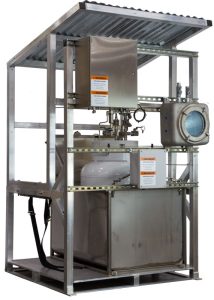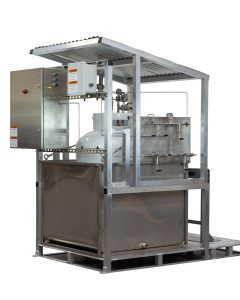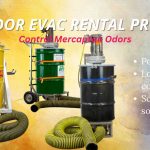Odorizer vs. Odorant: Do You Know the Difference?
In natural gas odorization, terms like odorization system, odorizer, and odorant are sometimes used interchangeably — but they mean very different things. Understanding the distinction is essential for anyone involved in gas safety, compliance, and system design.
The Basics
- Natural Gas: By itself, natural gas is odorless but combustible — a dangerous combination without a warning mechanism.
- Odorant: The chemical compound (often mercaptan-based) injected into the gas stream to give it a distinctive smell, typically described as “rotten eggs.”
- Odorization: The process of introducing odorant into natural gas.
- Odorizer: The equipment that performs this injection.
- Odorant Injection: An odorization method that injects odorant into a gas stream to make it detectable by smell. It may also be referred to as ‘chemical injection.’
Why Odorization Matters
Federal (49 CFR 192.625) and state regulations require that natural gas be odorized so that a leak is detectable by smell well before gas concentrations reach dangerous levels. This requirement, along with advancements in odorization technology, has shaped today’s odorization solutions.
Today’s GPL Odorizer Solutions
As of 2025, Linc Energy Systems is proud to be the Master Distributor for GPL Odorizers, offering a full range of odorization systems designed for diverse flow rates, pressures, and site conditions.
We are also a GPL Odorizers authorized service provider, offering 1-Source Odorization. This one-stop solution encompasses everything from equipment selection and installation to decommissioning and ongoing maintenance, handling every aspect of odorization needs.
Our Current GPL Odorizer Lineup:
GPL 750
Designed for natural gas and biogas lines in low-flow, intermittent, or even no-flow conditions, making it a perfect fit for municipalities and small city gate stations.
- Actuation: Differential pressure
- Pressure Range: 1–225 PSI
- Turndown Ratio: 180,000:1
- Temperature Range: 0–120°F (-18–49°C)
- Hazardous Area Class: CL I Div 2 (optional CL I Div 1)
GPL 5000
Developed for natural gas, RNG, biogas, and propane (LP) lines at medium pressure in low and high flow conditions, making it ideal for municipalities and small to large city gate stations.
- Actuation: Differential pressure
- Pressure Range: 1–400 PSI
- Turndown Ratio: 512:1
- Temperature Range: 0–120°F (-18–49°C)
- Hazardous Area Class: CL I Div 2 (optional CL I Div 1)
GPL 510
Engineered for natural gas, RNG, biogas, and propane (LP) lines at high-pressure in low and medium flow conditions, making it perfect for large city gate stations, transmission lines, municipalities, small city gate stations, and post-compressor RNG facilities. Future-proof design upgrades to GPL 10000.
- Actuation: Electric-powered dual bellows pump
- Pressure Range: Up to 1480 PSI
- Turndown Ratio: 25,000:1
- Temperature Range: 0–140°F (-18–60°C)
- Hazardous Area Class: CL I Div 2
GPL 10000
Created for natural gas lines in high-flow and high-pressure conditions, perfect for large city gate stations and transmission lines.
- Actuation: Electric-powered dual bellows pump
- Pressure Range: Up to 1480 PSI
- Turndown Ratio: 500:1
- Temperature Range: 0–140°F (-18–60°C)
- Hazardous Area Class: CL I Div 2
Key Advantages of GPL Odorizers
Every GPL odorizer is engineered for safe, accurate, and environmentally responsible odorant injection, utilizing patented technology for precise injection, which eliminates seal failures, reduces maintenance, and prevents emissions.
- Zero-emission design
- Odor-free operation & maintenance
- Streamlined operation & maintenance
- Advanced technology
- Reliable, safe & precise
- 24/7 technical support
Q&A: Odorization Systems Explained
Q: Is the odorant harmful to handle?
A: Odorants are hazardous and must be handled with proper PPE and safety procedures. GPL systems are designed to minimize operator exposure.
Q: How do I choose the right odorizer?
A: Selection depends on flow range, pressure, duty cycle, and regulatory requirements. Our team can help you determine the correct model using the GPL Odorizers Model Comparison Chart.
Q: Can GPL Odorizers be used for renewable gases like biomethane?
A: Yes. The technology is suitable for natural gas, biomethane (renewable natural gas), biogas, and other gaseous fuels requiring odorization.
Choosing the Right Partner
At Linc Energy Systems, we don’t just sell odorization equipment — we provide comprehensive turnkey solutions, from equipment selection and installation to operator training. As the Master Distributor for GPL Odorizers, we bring unmatched expertise to your odorization projects.
To talk with an odorization expert, call (303) 697-6701 or ‘contact us’ now to discuss your specific requirements.



